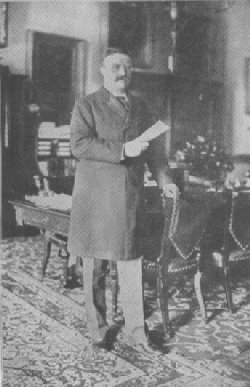In these days of improved railroad operations and precise manipulation of lines, delays are not looked for on important routes, and accidents have come to be exceptional. Consequently, most people may not perceive anything unusual in the progress of the President's train. But, although the ordinary express or accommodation train may maintain the schedule without unusual demands upon the railroad officials, this is not true of a presidential train. In this case, extreme precautions are taken in order that there may be the least possible danger of delay or accident. Of the extraordinary regulations necessary to insure the dispatch and safety of such a train no one but the interested railroad officials, themselves, can have any adequate knowledge or appreciation. The general supervisor of the whole trip and its details is, of course, the President's private secretary. When a trip is decided upon and the places to be visited are designated, the next thing is to fix the duration of the journey, and the secretary, in a general way, maps out the itinerary. A rough draft is submitted to the President for his approval, and when it is obtained, the secretary assigns the details to particular men, all specialists, and even experts, in their particular lines. The first to be consulted are the railroad men. Then the departure of the train is preceded several days by elaborate instructions to all the officials and trainmen who are to be in any way responsible for the care of the train. These instructions are very detailed, and reach even the humblest employes. They require that section men should be stationed at all crossings where there are no regular flagmen, and that a man should be stationed at all switches to guard them from being tampered with before the train passes. Roadmasters are instructed to go over their divisions in person before the President comes, and to observe and inspect everything. All the men concerned are ordered to be on hand at least 30 minutes before the presidential train is due to pass a given point, to insure the absolute safety of the people's executive. Engineers are instructed to use extra precautions, in going by stations, to guard against loss of life and any attendant delay, and also to keep the train well under control, so as to be able to make a quick stop in case of any sudden happening or apparent danger. In instances where the special schedule of the President's train interferes with the running of the regular trains, the regular service is retired for the time being, and the special train is given the right of way. The regular freight service also receives special attention, and is never allowed to interfere with the schedule of the presidential train. In fact, freight trains are usually kept out of the way, and are not permitted to be upon any main track over which the President's train is to pass. In addition to keen watchfulness along the line, the movement of the train is also safely guarded against any sudden breakdown in its own mechanical parts, by the continual presence of an expert carman, who knows a car thoroughly, and is able to do any repairing that may be necessary. An expert telegraph operator and lineman are also a part of the crew, so that in case of need the lineman can climb a pole and tap a wire, and then the operator would be in a position to communicate with any station along the route. In this way, messages of importance can be sent ahead of the train, and in case of a serious breakdown, assistance can be summoned from a distance. The provisioning of the train is an important matter. At the beginning of a trip about 300 pounds of beef, 200 pounds of lamb, 125 pounds of ham, 250 pounds of chicken, 30 boxes of geese, 100 pounds of turkey, 150 pounds of fish, three bushels of clams, 25 pounds of lobsters, ten gallons of ice cream, a miscellaneous supply of vegetables, fruit, eggs, canned goods, cheese, sugar, flour, bread, crackers and similar articles are packed away in the refrigerator car. Frequently, perishable goods must be taken on along the route, at points arranged beforehand, and the water and ice tanks must be constantly replenished. Ordinarily, a ton of ice is used daily. The convenience of the members of the party is further attended to by "Whitehouse" messengers, who care for the baggage during the longer stops, and make such special arrangements as the party may desire. One of the important duties of these messengers is to check up the members of the party after each stop, to see that none is missing. HOW AND WHERE THE WORLD GETS ITS MEAT |
